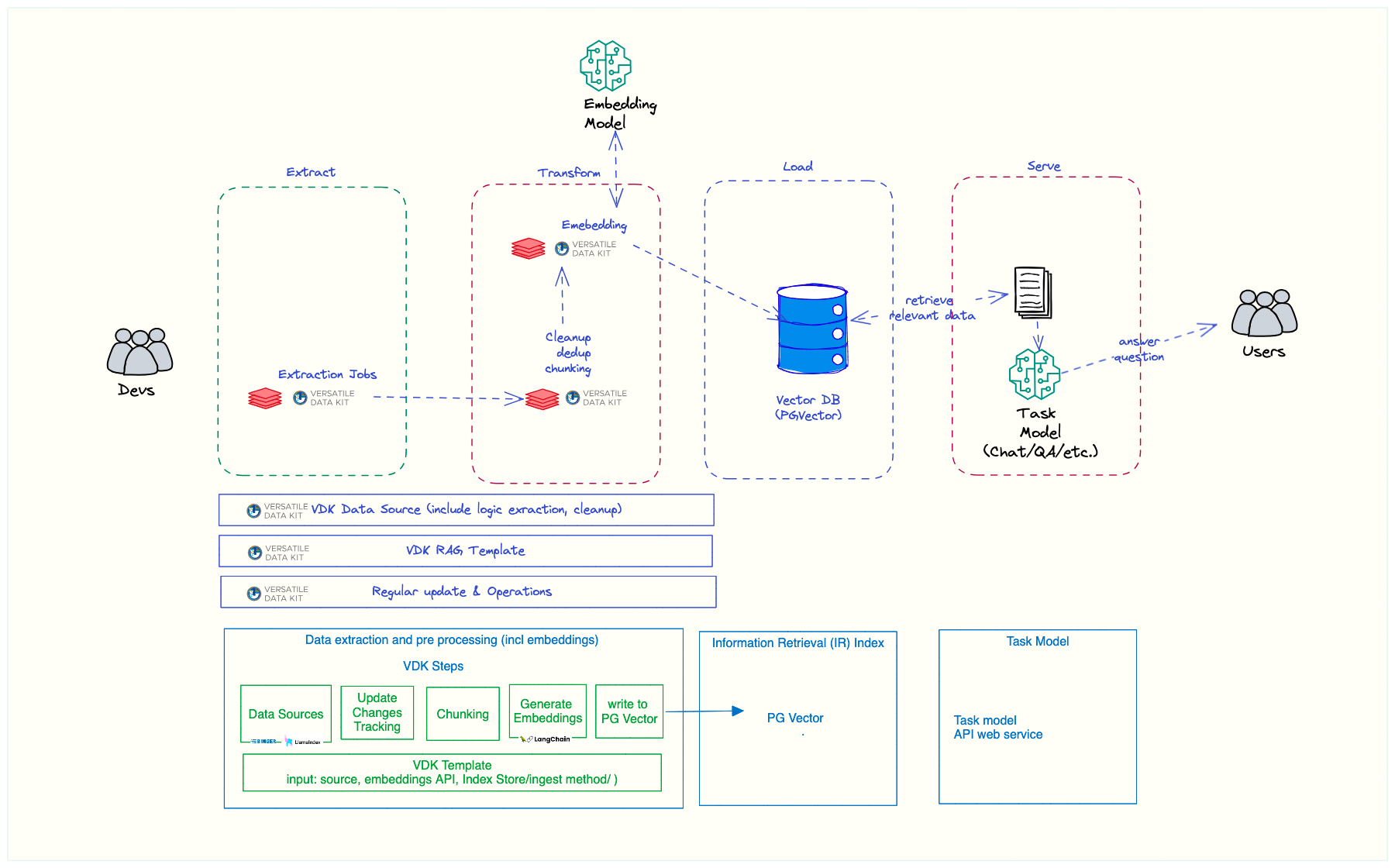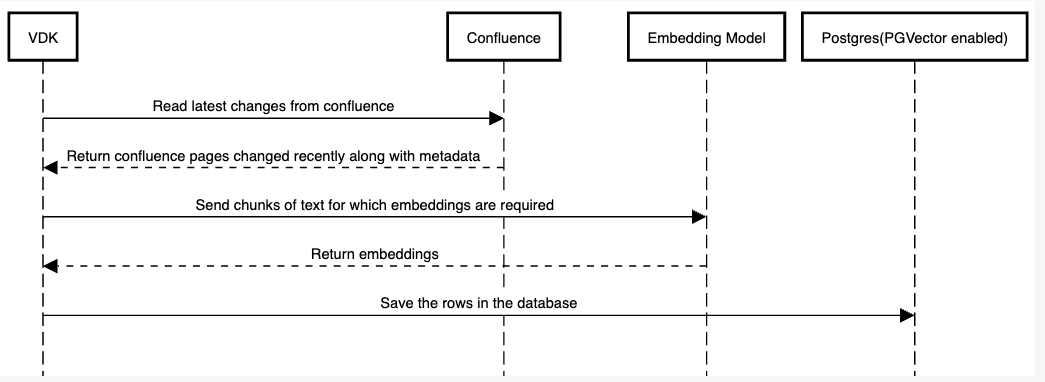- Author(s): Paul Murphy ([email protected]), Antoni Ivanov ([email protected])
- Status: draft
- Summary
- Glossary
- Motivation
- Requirements and goals
- High-level design
- API Design
- Detailed design
- Implementation stories
- Alternatives
With the rise in popularity of LLMs and RAG we see VDK as a core component to getting the data where we need it to be. VDK's strengths are ETL tasks. We see that its very well suited to populating the databases needed for RAG.
LLM: Large language model. The most ubiquitous example of this is chatgpt. It is a specialized type of artificial intelligence (AI) that has been trained on vast amounts of text to understand existing content and generate original content.
RAG: Retrival augmented generation. Additional information is passed to the LLM through the prompt. This additional information can help it generate better and more context aware responses.
Vector database: A database which supports storing vectors(arrays of numbers) and doing similarity searches between vectors(cosine distance, dot product etc...).
PGVector: A postgres extension which enables similarity searches in postgres and a vector datatype.
Chunk: A piece of text which it makes sense to create an embedding from. Lets look an example. In the case where we are saving confluence docs into a vector store it would be most obvious to create an embedding per paragraph. However we might find that it really helps to include the page title along with the paragraph when creating the embeddings.
Every ML project has some form of data preprocessor that is used to prepare data for input into a model. This preprocessor is typically created from scratch for each project. That creates inconsistency and fails to take advantage of prior work. This means every project needs:
- Data collection: Figure out how to connect to different sources, extract data, parse it, model it.
- Data cleaning: Do all similar data clean up for that source (all companies tool like confluence, likely 80% of data clean up on confluence data would be similar)
- Ensuring data freshness: track changes incrementally (if volume is big)
- Ensuring Data Privacy and Security - implementing measures to protect sensitive data.
- Setup a data pipeline that chunks appropriately and create embeddings
In short there's a need for standardized, modular preprocessing tools that can be easily adapted across different projects.
A company has a powerful private LLM chatbot. However they want it to be able to answer questions using the latest version of confluence docs/jira tickets etc... Retraining every night on the latest tickets/docs is not feasible. Instead, they opt to use RAG to improve the chatbot responses.
This leaves them with the question. How do we populate the data? Steps they need to complete:
- Read data from confluence/jira or any other data source
- Chunk into paragraphs(or something similar)
- Embed into vector space
- save Vector and paragraph in vector database
- remove old information. For example if we are scraping jira every hour and we are writing details to the vector database we need to make sure we clean up all embeddings/chunks which were generated from old versions of the ticket.
We will build a datajob in VDK which reads data from confluence or jira and writes it to a postgres instance with PGVector enabled. A embedding model will be running on a different machine which will be exposed through an API. We will make requests to the API to create embeddings for us.
After this datajob is running we will create a template from this in which we think customers will be able to adopt to meet their use cases.
They will be able to follow our template to quickly create similar jobs. This gives customers the ability to get up and runnning quickly.
- Provide a template-based pipeline construction that is customizable at any stage.
- It should chunk up the information, embed it and then save it
- The systems should be easily configurable
- Read from different sources chosen by user from a catlaog of configurable data sources
- facilitate incremental updates and changes tracking
- Different chunks sizes and strategies
- Different embedders
- Extra columns saved in database
- There should be an example on how to build your own ingestion pipeline or customize further this one.
- Only scraping new data and removing old data must be supported
- This only populates information into a database that could be used by as RAG system. We don't handle stuffing the actual prompts.
This is where VDK fits in a ML data pipeline. The goal is to automate and accelerate the ETL phase of ML pipeline as shown in below diagram.
https://github.com/vmware/versatile-data-kit/tree/main/projects/vdk-plugins/vdk-data-sources already provides a catalog of pre-built data source plugins that developers can select from. Each data source plugin will come with built-in logic for data extraction and information on incremental updates.
Already provide with VDK through the Ingestion Plugins One limitation that need to be addressed is that hte Ingestion plugins do not support more than one configuration per method. In another words only 1 postgres destination instance or 1 oracle destination instance per data job.
A dynamic template that allows developers to specify data sources, embedding APIs, and the vector database. The template will automatically generate the pipeline, including logic for tracking changes, chunking the data, and generating embeddings.
Ability for developers to further customize the pipeline by editing or replacing any of the components within the template. Documentation and examples on how to make such customizations effectively.
The framework will incorporate an intelligent change detection system that monitors data sources for any additions, deletions, or modifications. It does so by keeping state after each ingested payload is processed.
Options for developers to define custom chunking parameters, including chunk size and chunking criteria, to suit the specific needs of their applications
User should be able to reuse chunking logic defined in LangChain . For example different text splitter in https://js.langchain.com/docs/modules/data_connection/document_transformers/
Each pipeline can be tested in "unit-testable" (pytest) way using vdk-test-utils library Evaluation feature could be added in the future to evaluate the data stored in the Vector Database against Q/A set.
Using confluence example the activities done by VDK look like:
The api design should be heavily influenced by: https://python.langchain.com/docs/modules/data_connection/vectorstores/.
The table should have a structure like
| embedding | text chunk | document id | metadata |
|---|---|---|---|
| [1,2,3,4,5,6] | in this document blah... | 15 | {"groups_with_access": ["IT", "HR"]} |
| [1,2,3,3,5,6] | other content from same doc | 15 | {"groups_with_access": ["IT", "HR"]} |
# Initialize the Confluence to Vector Database pipeline
pipeline = vdk.ToVectorPipeline(ConfluenceReader(credentials), PostgresInstance, MyEmbeddingApi())
# Execute the pipeline to update the Vector Database with the latest Confluence data
pipeline.update_vector_database(last_timestamp)The python code could look something like this. In it we:
- delete any files that have been removed since the last scrape
- Then in a transaction delete all information for a page and in the same transaction write all the new information page
- The embedding api is abstracted into it own class allowing users to easily provide their own embedding API
Internally the ToVectorPipeline may do something like that (very simplified for bringing more clarity purpose):
PostgresInstance.delete(ConfluenceReader(credentials_for_confluence).find_removed_document(last_timestamp))
raw_page_or_tickets : Iterable[Union[PageChanges]] = ConfluenceReader(credentials_for_confluence).load(last_timestamp)
with postgres_start_transaction as transaction:
PostgresInstance.delete([a.document_id for a in raw_page_or_tickets])
documents = CharacterTextSplitter(chunk_size=1000, chunk_overlap=0).split_documents(raw_page_or_tickets)
PostgresInstance.from_documents(documents, MyEmbeddingApi())
